The ability of most plants; except epiphytes and halophytes, to grow and reproduce depend on the soil. Their roots absorb the mineral laced water needed for photosynthesis required for growth and cell functions.
Roots have 4 main functions which are anchoring the above ground parts of the plant to the ground, and supporting it, the absorption of water and inorganic nutrients through osmosis, the storage of food and nutrients particularly in plants Daccus and potatoes and vegetative reproduction.
Transpiration pull is when evaporated water from the leaves causes a low pressure area in the leaves and a concentration of salts. The water from the xylem in the root zone moves up the plant to the areas of lower pressure and where the higher salt concentrates occur. This in return creates a corresponding low pressure zone inside the xylem around the roots from the soil. The removal of water from the root xylem by transpiration pull reduces the water in the root xylem, creating a pressure difference between the soil water and the root xylem that in return creates water inflow.
The structure of roots gives them a rather large surface area to compensate for the slowness of uptake by any one root and provide an adequate total uptake of water. This osmotic absorption mechanism enables plants to take up water from soil that appears to contain no liquid water and cannot be used as a water source by animals.
* Roots – Develops from the embryo radical and grows downward taking the path of least resistance.
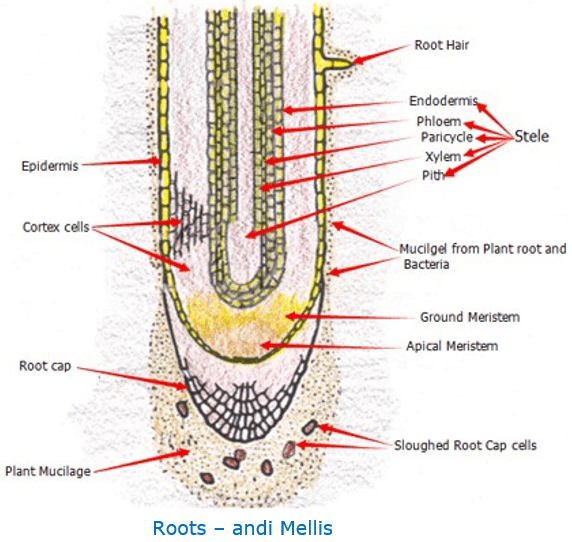
Root Tissues
* Stele – is the collective term for the Vascular Bundle including the Xylem and Phloem.
* Vascular Bundle – Are the cells that immediately surround and protect the xylem and phloem. They are a part of a complex transport system for water and minerals in the water of vascular plants. The movement of water and minerals occur in the stems. This exists between the xylem -water and minerals from the roots to the green structures and the phloem – water and minerals in both directions to aid growth, stability and health. Both these tissues are present in the vascular bundle, which includes support and protective tissues. In dicotyledon plants the vascular bundles are situated in a ring near the outside of the stem, with the phloem on the outside of the xylem. In monocotyledons the bundles are scattered randomly.
* Xylem – Are special water conducting cells from the roots to the leaves found in angiosperms and to a lesser extent in Gymnosperms. The term “xylem” comes from the Greek xylon, wood because the cells are found on the inner bark against the true wood.
* Phloem – Are special sugar conducting cells from the leaves to the roots found in angiosperms and to a lesser extent in Gymnosperms. The term “phloem” comes from the Greek phloios, bark because the cells are found closest to the bark.
* Endodermis – is the central, innermost layer of cortex in some land plants in the vicinity of the growing tips of shoots and the active absorption parts of roots. It is made of compact living cells surrounded by an outer ring of endodermal cells that are impregnated with hydrophobic substances; a Casparian Strip which restricts the apoplastic flow of water to into the vascular bundle. They are large cells bounded between the cortex and the stele and are often referred to as part of the stele. In most seed plants, especially woody types, an endodermis is absent from the stems but is present in roots.
* Cortex – the cortex is the outermost layer of the stem or root of a plant, between the epidermis on the outside and the endodermis on the inside. It comprises mostly of differentiated cells, usually large thin walled parenchyma cells in the green parts. The outer cortical cells often acquire irregularly thickened cell walls, and are called collenchyma cells. Some of the outer cortical cells may contain chloroplasts in the leaves. In the roots it is responsible for the transportation of materials into the central cylinder of the root through diffusion and may also be used for food storage in the form of starches.
* Epidermis – is a single layer of cells that covers the plant’s leaves flowers, roots and stems where it forms a boundary between the plant and the external environment. The epidermis serves several functions protecting the inner cells, secreting metabolic compounds and absorbs water and mineral nutrients.
* Root cap region – or calyptra contains statocytes which are involved in gravity perception in plants. If the cap is carefully removed without damaging the apical mericap the root will grow randomly. The root cap also secretes mucilage as it penetrates the soil elongating downwards and outwards while protecting the apical meristem.
* Apical meristem region – Is the active growth region of the root. The leading section produces new root cap cells as old ones are discarded. The ground cells are completely indeterminate meristem cells in a plant that form three kinds of primary meristems. The primary meristems will eventually produce the vascular bundle cells, cortex cells and lateral growth cells.
* Elongation region – These cells are rapidly produced in the apical meristem elongating, producing small vacuoles within the cytoplasm coalesce each filling with water. One or two large vacuoles occupy almost all of the cell volume in fully elongated cells. Cellular expansion in this zone is responsible for pushing the root cap and apical tip downward through the soil.
* Root hair region – occurs a short distance behind the region of elongation in the epidermal cells. Here a large number of filiform lateral growths are formed. The root hairs are short and short- lived and develop on the primary and secondary roots. A root-hair consists of the thin cell walls, a large surface area for better absorption of water and minerals, a thin lining of cytoplasm which contains the nucleus and a comparatively large vacuole containing cell sap.
* Mature region – Is the region where cork begins to replace epidermal cells. This greatly reduces the ability of this area of the root to absorb water and minerals. The root hairs are not replaced in this area when lost in most species unless damaged.
Types of Roots (based on position and origin)
* Primary – Is the main seed root; the first root to grow from the radical of the embryo following germination. It is the leading root of a plant.
* Secondary – Is any root sprouting from the pericycle within the primary root; lateral roots. The pericycle is the ring of cells immediately outside the Vascular Bundle and the endodermis and is 1 or more cells thick.
* Adventitious – Is any root rising from an organ other than root, such as the lower portion of the stem, branches or nodes.
Stems – The stems have 2 main functions. They are to support the flowers and leaves and to provide transportation of water and minerals from the roots to the leaves and sugars from the leaves to other parts of the plants.
* Caulescent plants produce leafy stems with appendages which include leaves and flowers growing from their nodes or apices.
* Acaulescent plants are generally stemless and have basal leaves with either a very short stem or no above ground stem and a leafless flower stalk.
A stem of a flowering plant is normally divided into nodes and internodes dividing the nodes where a leaf, leaves or buds are attached. Although the root and stem share many common structural features, the root bears no or few appendages.
Herbaceous stems have very little woody tissue. The epidermis is similar to that of leaves, having a single cell layer that secretes a waxy cuticle onto its outer wall.
* Monocot stems have vascular bundles present throughout the stem which are concentrated towards the outside. The shoot apex in monocot stems is more elongated with the leaf sheathes growing up around protecting them. This is true to some extent of almost all monocots. Monocots rarely produce secondary growth and are therefore seldom woody. The palms and bamboos are noticeable exceptions with many monocot stems increase in diameter via anomalous secondary growth. Each bundle is surrounded by a sheath of elongated, sclerenchyma fiber cells with thickened walls for mechanical support for the stem.
* Dicot stem growth has pith in the center, with vascular bundles forming a distinct ring visible surrounding this pith when the stem is viewed in cross section. The outside of the stem is covered with an epidermis, which is covered by a waterproof cuticle. The epidermis also may contain stomata for gas exchange particularly in young shoots and herbaceous shrubs and multicellular stem hairs called trichomes. A cortex consists of Hypodermis (collenchyma cells) and an Endodermis of cells containing starch that is present above the pericycle and vascular bundles.
Herbaceous stems live for different lengths of time:
Annual plants – live for only one growing season.
Biennial plants – live for 2 growing seasons. In the first season the plants grow the vegetive parts followed by the reproductive parts before dyeing in the second season. Note a season maybe a part of a year of a full year.
Perennial plants – live for more than 2 growing seasons and can live for thousands of years.
A continuous vascular cylinder eventually develops into a young woody stem:
* Leaf traces – Is the extension of vascular strands from a plant’s stem into a nearby leaf, resulting in a leaf gap in the plant’s stele. The gaps soon close by secondary growth, resulting in a solid cylinder of xylem and phloem.
* The xylem portion of the stem is the previous seasons growth of dead cells which becomes the heart wood of the tree or stems. in woody growth shrubs.
* The bark is the outer most portions of a trunk, stems and upper roots. The inner living part of the bark is known as the periderm. The outer bark in older stems includes the dead tissue on the surface of the stems, along with the living tissue of the innermost periderm. All the dead tissues on the outer side of the peridermis are known as the rhytidome. The inner includes the tree’s phloem, while the outer rhytidome consists of multiple layers of protective tissue known collectively as cork.
* Growth rings – Are bud scale scars from the last terminal bud or they denote flushes of annual growth in a tree trunk or limb.

Morphology of Tree Rings
Tree rings can tell us many things about the Earth’s history, like climate history. Tree rings are formed from the center of the tree outward. The ring closest to the bark is the youngest and final growth ring. The ring closest to the center of the tree is the oldest growth ring.

Similar ring patterns are found in trees growing under the same conditions in the same locations. The most obvious feature of these rings is the variable widths of the bands. The wider the rings, indicates good growing seasons, while narrower rings indicates poor growing seasons or adverse seasons. Conditions that affect the widths include climatic factors such as temperature, rainfall and soil moisture as well as other factors like erosion, fire, landslides or disease.
Before reading the rings you need to be able to “count” the tree rings. Tree ring patterns are alternating dark and light bands. The deeper coloured bands in the cross section represent the end of a growing season. The paler coloured space between the two deeper coloured bands represents one growing season. Neither the bark nor the central circle of pith is counted as a growth ring so do not include these when counting.
Dendrochronology:
( Dendrochronology is from the Ancient Greek, ???????, dendron a tree, ??????, khronos, Cronos for a time line and -?????, logia to study. In other words tree age study.)
Tree ring dating there fore is the scientific method of dating based on analyzing the patterns of tree rings, also known as growth rings in the cross section of the trunk or limb of a tree or stem on a shrub. Dendrochronology can date the time at which the tree rings were formed, in most types of wood, to the exact calendar year it occurred. Growth rings or annual rings can be seen in a horizontal cross section cut through the trunk of a tree. Growth rings are the result of new growth in the vascular cambium. This growth in diameter is known as secondary growth. Visible rings result from the change in growth speed through the seasons of the year, thus one ring usually marks the passage of one year in the life of the tree. The rings are more visible in temperate zones or cooler mountainous zones, where the seasons differ more than in the tropics.
A Tree is defined as having a single woody stem a trunk usually growing from a single base or several trunks from a lignotuber in the case of many Australian mallees.
A shrub is defined as having several woody stems usually growing from a single base or can be several stems growing from near the base of the from a lignotuber.
* Trunk – refers to the main wooden axis of a tree. It is an important diagnostic feature in tree identification because it differs remarkably from the bottom of the trunk to the top, depending on the species.
* Bole – The lower part of a tree trunk which is that section between the ground and below the first branches.
Stem Morphology
* Fruticose growth – are the shrubby stems that are more or less woody throughout as seen in shrubs.
* Suffrutescent growth – Are semi shrubby stems that turn woody in the lowest parts and remain alive over the winter or dry season when the upper parts die back.
* Branch – A stem that is more than 1 year old, typically with lateral stems or branchlets radiating from it.
* Twig/Branchlet – A young stem which is 1 year old or less that is in the dormant winter stage and or has no leaves.
* Shoot – A young stem which is less than 1 year old with leaves.
* Bud –A young shoot developing from the node, apex or a flower prior to opening. See Glossary page 11.
* Terminal bud – Is a bud positioned at the end of a stem and responsible for terminal growth. See Glossary page 11.
* Axillary bud or Lateral bud – Are the buds along the side of the axis of a stem usually at the nodes. They are produced by the terminal bud during growth. When they grow out and form a lateral stem they become terminal buds of the lateral stem. See Glossary page 11.
* Flower bud – Is a bud containing a floral meristem which develops into flowers; usually larger than vegetative buds.
* Node –A lumpy point along a plant’s stem that will grow a new branch, leaf, flower or root.. See Glossary page 11.
* Internode –The section of the stem which is between two nodes. See Glossary page 11.
* Leaf scar –Is a scar which is made from the former point of attachment of a leaf or petiole to the stem. See Glossary page 11.
* Lenticel – Are small scale like projections on the trunks, branches, stems and some fruits which compose of loosely packed cells extending from the cortex through ruptures on the epidermis. They serve as “breathing pores” for gas exchange. See Glossary page 11.
* Pith –The spongy material in the hollow sections of a stem, branch, in culms or grasses and reeds or the pseudo bulbs of many orchids. See Glossary page 11.
* Prickles – These are NOT modifications of any existing organ of a plant. A prickle is entirely new organs. They are found any where and indiscriminately on the plant (stem, leaves or flowers). They develop from epidermal tissue only. Therefore they break off easily and are usually hooked. See Glossary page 11.
* Spines – Are modified leaves. I.e. The leaves have turned into or are reduced to spines. They are seen at the node where a leaf is expected or are an extension to the leaf’s apex. See Glossary page 11.
* Thorns – Are modified branches or stems. They either develop from the terminal or lateral buds. They are seen only at the node of a plant. They are endogenous in origin i.e. from the vascular tissue and often have leaves. See Glossary page 11.
* Glochnidiate – With small barbed bristles. See Glossary page 11.
Stem Structural Types
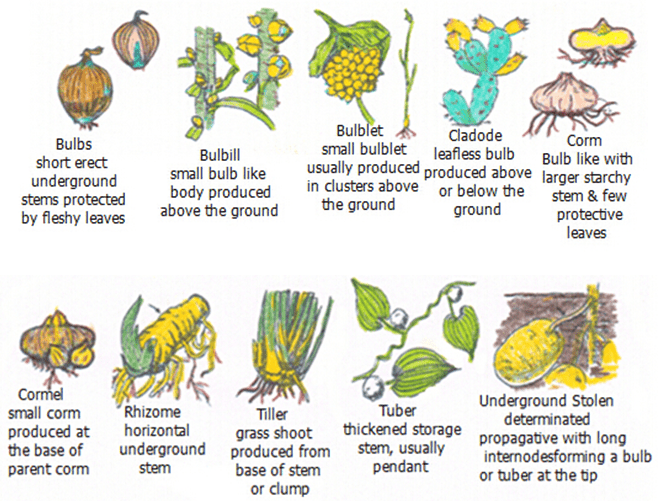
Meristems are growth regions of a plant
Apical meristems are located at the apex, of each stem and root.

Lateral meristems increase the diameter of the plant’s trunk, branches, stems and roots and are the live cells beneath the bark in the cambium layer. The term secondary growth refers to the dead cells of the previous season’s xylem cells that make up the wood.
Cell division involves the distribution of identical genetic material, DNA, to two daughter cells. Active cell division takes place at the Apical meristem and the lateral meristem. What is amazing is the fidelity that the DNA is passed from one generation to the next in perpetuity without dilution or error. This growth is known as primary growth and perpetually reproduces leaf and bud primordia, which develop into new leaves, lateral shoots, respectively and new roots and root hairs.
The vascular cambium produces the vascular tissue (xylem and phloem) for the plant and lies between the previous season’s dead wood and the inner bark. During secondary growth, new xylem cells are formed by the vascular cambium while the old cells’ walls become thickened with cellulose and lignum, strengthen and die. As the branch or trunk enlarges in circumference, these cells make up the bulk of the stem tissue, forming the secondary xylem, or what is known as wood. Thinner walled phloem cells divide outward from the vascular cambium, surrounding the wood forming the inner bark.
The cork cambium is the second lateral meristem. The cork is the outer most portions of a trunk, stems and upper roots. The cork in older stems includes the dead tissue on the surface of the stems and is known as the rhytidome.
Grasses meristem tissues are at the nodes along the stem from just above ground level. Grasses continue to grow from these intercalary meristems and can repeatedly renew themselves after grazing.
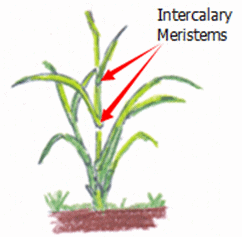
Plant responses to environmental stimuli
Phototropism is the phenomenon within plants and fungi to be able to grow towards a light source. (Photos is Greek for light and tropos is Greek for to turn.)
The cells on a plant farthest from the light source have a chemical called auxin/s, which accumulates on the dark side of the stem and reacts when phototropism occurs. Auxin causes the elongation of cells forcing the stem to grow towards the light source. Growth towards a light source is known as positive phototropism, while growth away from light is called negative phototropism. Most plant shoots exhibit positive phototropism also rearranging the position of their chloroplasts in the leaves to maximize photosynthetic energy and promote growth. Some vine shoot tips exhibit negative phototropism, which allows them to grow towards dark, solid objects and climb them. Young shoots are the quickest to respond to changes in light conditions bought about by shading.
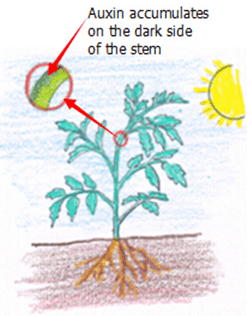
Gravitropism is the plants response to gravity. It is the turning or growth movement by a plant or fungus in response to gravity. Charles Darwin was one of the first to scientifically document that roots have positive gravitropism and stems show negative gravitropism. This is easily observed when a potted plant is placed on its side. The shoots will immediately commence growing upwards; positive Gravitropism, while the roots immediately commence growing downwards, negative gravitropism.
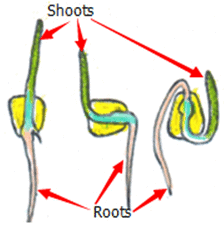
The chemistry for the change in the direction of growth is similar to that for phototropism. Under the influence of gravity, auxin accumulates in the lower side of the stem. Here, the hormone stimulates growth, causing the lower side to elongate quicker than the upper side, bending the stem upwards.
Remarkably and not fully understood the opposite happens in roots. The auxin again accumulates in the lower side of a horizontal root. However, root cells behave differently than stem cells do. Root cells elongate in response to lower levels of auxin in the upper surface, causing the roots to bend downwards.
Hypothesis
Hypothesize that seeds germinating while being spun on an old record player turntable at 45 RPMs will have their roots and stems growing parallel with the Earth, rather than perpendicular as they normally would in a dark environment, in an environment with light the roots would grow parallel to the earths surface while the shoots would grow towards the light.
Materials’ List
* 2 Record player turntable
* 1 package of radish seeds
* 10 small plastic drinking cups (about 5 ounces)
* Sheet of stiff cardboard or poster board
* Paper glue
* Potting soil
* Water
* Eyedropper
* Scissors
* 15 days of time to record results.
Procedure
LP record albums are 12 inches in diameter. Cut a 12-inch diameter circle from a piece of stiff cardboard or a sheet of poster board. With a pencil point or scissors, poke a hole in the exact center of the board, so it will slide over a turntable’s spindle.
Place potting soil into the 5 small plastic drinking cups, to a depth of one inch. Moisten the soil with water, but do not flood it.
Place 3 radish seeds into the soil near the center in each of the 5 plastic cups. The 5th cup is our control cup, which will prove that the seeds in the pack and the growing environment are viable. The 5th cup is to be placed adjacent to the record player.
Push the cardboard disc over the spindle and down onto the platter of a record player turntable. Be sure the disc moves when the turntable is spinning, and that the disc’s hole is not too tight around the spindle.
At 12, 3, 6, and 9 o’clock of the cardboard circle, place a few drops of glue. Set a cup on each spot of glue and allow to set hard.
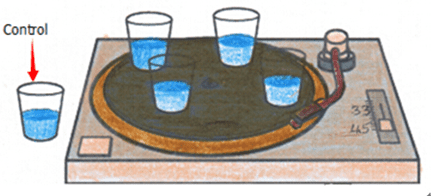
Place the turntable adjacent to a window with plenty of light and turn it on setting it at a speed of 45 RPMs).
Daily, add water equally to all five cups to keep the soil slightly moist. Use an eyedropper to ensure an equal quantity of water is added to all cups. The turntable must run continually, except when you’re adding water or making observations.
Make observations daily for 15 days, and write down your results of what you observe.
Repeat: with a second turntable in a dark position like inside a cupboard where no light can influence the growth.
Results
Write down the results of your experiment. Document all observations and data collected. Did the seeds germinate? Which direction; relative to the Earth’s surface, did the roots grow? Which direction did the stems grow?
Conclusion
Come to a conclusion as to whether or not your hypothesis was correct.
Thigmotropism Thigma is Greek for to touch. It is the movement in which a plant moves or grows in response to touch or contact with a stimulus. The most common form is found in climbing vines as their stems bend around an object looking for support. Climbing plants, also develop tendrils that coil around supporting objects. Touched cells produce auxin and transport it to untouched cells. The auxin untouched cells will then elongate faster so cell growth bends away from the auxin cells and around the object it is touching. Others include carnivorous plants which respond to touch on 2 or more hairs and the sensitive plant when the leaves fold and drop in response to being touched by grazing animals.
Nastic Movement is the rapid movement found in some plants like Mimosa pudica which is well known for its rapid plant movement. The leaves close up and droop when touched. They are non directional responses to stimuli like temperature, humidity, light irradiance or touch pressure. The movement can be due to changes in turgor or changes in growth, therefore Potassium ion concentration usually controls such movement in plants and is not auxin related. Nastic movements are independent of the stimulus’s position. The rate or frequency of these responses increases as intensity of the stimulus increases.
They are named with the suffix “nasty which is Greek to press on” and have prefixes that depend on the stimuli.
Epinasty – downward-bending from growth at the top, for example, the bending down of a heavy flower.
Hyponasty – Is where the upper surface bends upwards like the leaf apexes or margins of a leaf in response to light, darkness or moisture.
Photonasty – Is the response to light – Flowers opening during the day and closing at night or vice versa.
Nyctinasty – Is the response to movements at night or in the dark.
Chemonasty – Is the response to chemicals or nutrients. The activation of enzymes to dissolve insects in carnivorous plants is a good example.
Hydronasty – Is the response to water. The pulvinus movement at the base of the phyllodes of most Acacia is a good example.
Thermonasty – Is the response to temperature.
Geonasty/Gravinasty – Is the response to gravity.
Remember
- The ability of plants to grow and reproduce depends on the soil, from which their roots absorb water and minerals required for photosynthesis.
2. Water absorption by roots is basically an osmosis process.
3. Transportation Pull caused by evaporation in the leaves removes water from the root xylem causing a low pressure area which causes water to diffuse from the roots along the xylem to the leaves due to the differentiating pressures.
4. The cortex of the root serves as an area for food storage.
5. The root cap protects the apical meristem of a root.
6. An increase in the length of a root occurs in the apical meristem region.
7. A root growing from the lower portion of the stem is known as adventitious roots.
8. A persistent, well-developed primary root is a mature root.
9. Caulescent plants produce ordinary leafy stems with appendages, such as leaves and flowers growing from their nodes.
10. Acaulescent plants have basal leaves and no recognized stem.
11. Herbaceous stems have very little woody tissue.
12. The vascular cambian produces the growth in diameter of a stem.
13. The xylem is the vascular tissue that eventually becomes the “wood” of a tree.
14. The inner part of a tree’s bark contains the vascular tissue phloem and is known as the periderm while the outer dead corky section is known as the rhytidome.
15. A young stem with leaves is called a shoot.
16. The center most tissue of a stem is called the pith.
17. A rhizome is a horizontal underground stem.
18. The apical meristem is where active cell division occurs.
19. The lateral meristem growth increases the diameter of the plants stems and trunk.
20. Most plant growth that responds to environmental stimuli are produced by the influence of the hormone auxin.
21. The point on a stem where leaves are attach is a node while the area between the nodes is known as the internodes.
Further Comments from Readers:
All information is included in good faith and has been thoroughly researched prior to printing. The website or the author does not warrant or guarantee the accuracy of any information on these pages, nor does the website or the author accept any responsibility for any loss arising from the use of the information found within. The views and opinions are strictly those of the author or those members who chose to actively, participate in the contents herein.
“Hi reader, it seems you use The Bible of Botany a lot. That’s great as we have great pleasure in bringing it to you! It’s a little awkward for us to ask, but our first aim is to purchase land approximately 1,600 hectares to link several parcels of N.P. into one at The Pinnacles NSW Australia, but we need your help. We’re not salespeople. We’re amateur botanists who have dedicated over 30 years to saving the environment in a practical way. We depend on donations to reach our goal. If you donate just $5, the price of your coffee this Sunday, We can help to keep the planet alive in a real way and continue to bring you regular updates and features on Australian plants all in one Botanical Bible. Any support is greatly appreciated. Thank you.”
In the spirit of reconciliation we acknowledge the Bundjalung, Gumbaynggirr and Yaegl and all aboriginal nations throughout Australia and their connections to land, sea and community. We pay our respect to their Elders past, present and future for the pleasures we have gained.